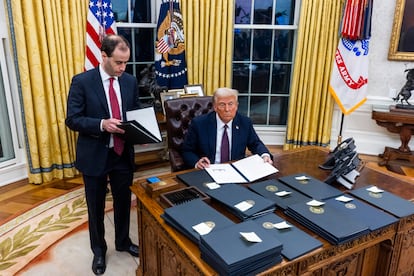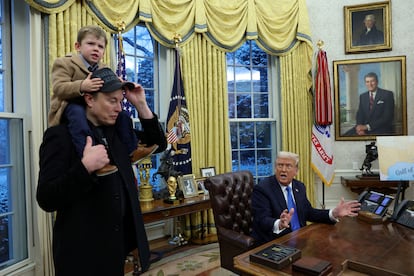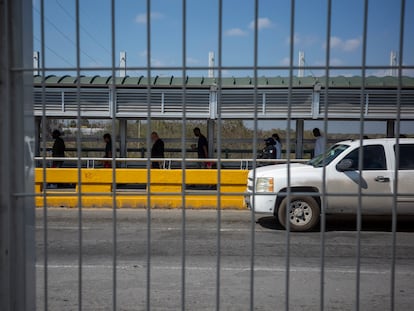Trump shakes up the United States in a vertiginous first month in office
The president’s decisions are redefining the role of the world’s leading power and beginning to create victims within the country

A swipe at the geopolitical chessboard, a large-scale trade war, the persecution of undocumented immigrants, a revenge-driven purge, mass layoffs in the Administration, numerous lies and a cultural war on progressive ideas have all marked Donald Trump’s vertiginous first month back in office. Displaying a frantic activity in which he has combined important decisions with distraction maneuvers, the president of the United States is redefining the role of the world’s first power while shaking up the domestic political, economic and social landscape. The country has changed tack sharply with Trump at the helm and the billionaire Elon Musk as his sidekick.
In his first month as the 47th president, Trump has signed dozens of executive orders and memorandums. Some of his decisions have clear and immediate victims, such as immigrants, federal workers, recipients of international aid and transgender people. Others are mere programmatic or propaganda statements without any normative content. The president has appeared almost daily before the media from the White House or his Mar-a-Lago property to try to pass off as common sense his most absurd lies or ideas, such as that Ukraine started the war with Russia, or that the Gaza Strip should be a real estate development owned by the United States.
Trump returned to office with a thirst for power. He came back with four years of experience as president and four more of preparation for his return. He also felt strengthened by the obstacles he had to overcome on the campaign trail, including his criminal charges and an assassination attempt, which now makes him present himself as chosen by God. He serves with the backing of a Supreme Court ruling that declares him immune from criminal liability for any acts he performs as part of his duties while in office. From day one he has shown a willingness to test the limits of his power and to strain the seams of the Constitution and the separation of powers. “He who Saves his Country violates no law,” he tweeted on Saturday, a phrase attributed to Napoleon Bonaparte that reflects his current approach to his own role.
To a large extent, what Trump has done this month has not come as a surprise. Xenophobia was a mainstay of his campaign, which was also peppered with revengeful messages on the political and cultural levels and a promise of a “drastic reform” of the administration courtesy of Elon Musk. Mass deportations, widespread tariffs and persecution of political enemies were central messages of his campaign, which also suggested there would be full support for Israel and a rapprochement with Russia at the expense of America’s commitment to Ukraine, the European Union and NATO.
According to a CBS/YouGov poll conducted Feb. 5-7, 53 percent approved of his performance and 47 percent disapproved, but 70 percent believed Trump was delivering on his campaign promises.
Starting with his inaugural address, he broke with the institutionality of such an event, harshly criticizing his predecessor and painting a false apocalyptic image of the United States, then presenting himself as a providential savior to lead the country to a new “golden age,” as he called it. In his inaugural address, he said that the United States was going to take back the Panama Canal and announced that he was renaming the Gulf of Mexico the “Gulf of America.”
Trump did not even wait to arrive at the White House to issue his first decrees. In a live display of populism, he signed the first decisions in an indoor sports stadium, much like a Roman circus, where thousands of people cheered him on ― and before him, Elon Musk, with his arm extended in what was reminiscent of a Nazi salute. He then continued signing orders in the White House, demonstrating that he is there with a clear and uncomplicated agenda. On the first day he announced the withdrawal of the United States from the World Health Organization (WHO) and from the Paris Agreement on climate change, and he renounced the OECD agreement to establish a minimum tax of 15% for multinationals. He also decreed the suspension of humanitarian foreign aid and stopped admitting refugees.
On January 20 he declared a double national emergency: one for energy (despite the fact that the United States broke production records under Joe Biden) and another one for immigration (although the acute phase of the problem was already behind). Many of the initial measures, from the controversial suppression of birthright nationality to the mobilization of the army and orders to facilitate deportations, focused on immigrants.
The Trump administration began to broadcast arrests and deportations, which succeeded in spreading panic and legal uncertainty in some communities. The expulsion figures in the first few weeks did not in fact differ much from those of previous administrations, but the heavy-handed display – including the resort to Guantánamo – caused a sharp drop in arrivals at the border with Mexico, a success for Trump’s immigration policy.
Trade war
On his first day in office, Trump also brandished his tariff threat against Mexico and Canada, which he set a date for: February 1. Over the weekend, he threatened Colombia with immediate tariffs for not accepting two military planes with deported immigrants. Gustavo Petro’s government was forced to give in to U.S. pressure. Trump also obtained minor concessions from the governments of Claudia Sheinbaum and Justin Trudeau that served to justify a suspension of the 25% tariffs for a month, until March 4, after keeping not only the two countries, but also American citizens and companies, in suspense.
The Republican also seemed willing to delay the 10% tariffs on China in exchange for some concession from President Xi Jinping, but he failed to achieve anything of the sort and the tariffs went into effect. However, in a show of improvisation, Trump had to backtrack and exempt most Chinese shipments from taxes due to a customs collapse and the inability to manage the new tariff.

Trump’s trade policy this month has been chaotic, full of threats that are not fulfilled, deadlines that are modified, and arguments that change and make no sense. The president has announced or threatened tariffs over fentanyl, immigration, VAT, the trade deficit, not accepting deportations, taxes... In his trade war design, there is no well-fitting spot for generalized tariffs, those aimed at specific countries, those falsely described as reciprocal, or those aimed at protecting products such as steel, aluminum, cars, semiconductors or pharmaceutical products.
The idea seems to be to equip himself with negotiating tools to extract economic concessions. With his policy, Trump is blowing up the entire international system structured around the World Trade Organization (WTO) and its rules. In doing so, he could end up damaging the international economy, but also the American one. Large companies have already warned of the potential impact of protectionist measures on the supply chain, inflation and economic growth.
Gaza and Ukraine
The bully style that Trump has displayed with tariffs is not limited to trade policy. The president is flirting with the idea of seizing the Panama Canal and Greenland and annexing Canada. But the day he left everyone speechless, including Republicans, was when he took advantage of the visit by Israeli Prime Minister Benjamin Netanyahu to the White House to launch his crazy idea of ethnic cleansing in the Gaza Strip, expelling its inhabitants so that the United States can take control of the territory and turn it into a real estate development with sea views.
That proposal on Gaza was a milestone for someone who proclaimed that his term would be one of “the revolution of common sense.” However, what has really set off alarm bells in Europe is Trump’s rapprochement with Russian President Vladimir Putin and the start of negotiations to end the war in Ukraine without bringing either the European Union or Volodymyr Zelenskiy’s government to the table.
Trump’s statement on Tuesday from his Mar-a-Lago mansion, blaming Ukraine for the Russian invasion, makes it very clear why European countries are beginning to see their main ally almost as an enemy. Trump has not only made a 180-degree turn from Joe Biden’s position regarding the war in Ukraine, but has also broken with traditional U.S. foreign policy since the Cold War. On Wednesday, he called Zelenskiy a “dictator,” widening the gap with Kyiv.
Musk's cuts
At home, after the offensive against undocumented immigrants, the focus has turned to cuts in the Administration. Trump believes that as president he has almost unlimited prerogatives over the entire executive branch. This week he decreed that independent bodies should cease to be so and should answer to him (with the sole exception, protected by law, of the Federal Reserve with regard to its monetary policy).
The White House suspended the disbursement of multimillion-dollar grants and loans to states, towns and non-profit organizations, despite the fact that these were approved by law. A judge overturned the decision, but the money has not flowed and the judge accused the Administration of failing to comply with her orders. The judges have led the resistance against Trump’s policies in this first month, with the precautionary suspension of several of his measures, including the repeal of the right to birthright citizenship. They also limited or prevented Elon Musk and his employees at the so-called Department of Government Efficiency (DOGE) from accessing the Treasury’s payment system.

Trump has given the billionaire carte blanche to approach government cuts as if it were one of his companies. His tactic is to cut first and ask questions later. Trump and Musk launched an incentive-based redundancy offer that some 75,000 federal employees signed up to. They then launched large-scale layoffs, starting with the hundreds of thousands of least protected government workers.
Trump and Musk, the most powerful couple in the United States, have launched accusations of fraud and corruption without providing evidence or filing charges. Showing their double standards and for political convenience, they have asked to drop the charges against the mayor of New York, Eric Adams, where the criminal evidence was clear. At the same time, both men act as if conflicts of interest do not matter. When Trump was asked if Musk had met (in a public building) with the Indian Prime Minister, Narendra Modi, in his capacity as a public official, the president replied: “I don’t know. They met and I assume [Musk] wants to do business in India.”
The administration’s budget cuts have been accompanied by a political purge at the Justice Department, the Federal Bureau of Investigation (FBI) and the firing of inspectors general, a kind of watchdog tasked with preventing corruption in federal departments and agencies. Trump opted to grant a blanket pardon to those who carried out the assault on the Capitol and to retaliate against those who acted against the crimes perpetrated that day.
As part of the conservative culture war, Trump has fired employees dedicated to diversity, equality and inclusion programs and targeted trans people. He has also replaced paper straws with plastic ones, ordered a halt on the production of pennies, renamed the Gulf of Mexico the Gulf of America and banned the Associated Press from the Oval Office and Air Force One for not adopting the new name. In the meantime, he appears to have abandoned his promises to lower prices.
In 1933, Franklin Delano Roosevelt signed 76 laws passed by Congress in his first 100 days in office to deal with the Great Depression. Since then, that period of just a little over three months has been the thermometer by which to measure the temperature of every presidency. Trump’s White House was too impatient to wait that long: on January 24, four days after taking office, it released the summary of Trump’s first 100 hours, a frantic succession of decrees, orders and declarations. Between now and April 30, when the 100 days are up, Trump will have to define his trade policy, clarify his role in the war in Ukraine and begin to work with Congress on his fiscal measures, among other things. There could be new surprises. The emotional rollercoaster is still in full gear.
Sign up for our weekly newsletter to get more English-language news coverage from EL PAÍS USA Edition
Tu suscripción se está usando en otro dispositivo
¿Quieres añadir otro usuario a tu suscripción?
Si continúas leyendo en este dispositivo, no se podrá leer en el otro.
FlechaTu suscripción se está usando en otro dispositivo y solo puedes acceder a EL PAÍS desde un dispositivo a la vez.
Si quieres compartir tu cuenta, cambia tu suscripción a la modalidad Premium, así podrás añadir otro usuario. Cada uno accederá con su propia cuenta de email, lo que os permitirá personalizar vuestra experiencia en EL PAÍS.
¿Tienes una suscripción de empresa? Accede aquí para contratar más cuentas.
En el caso de no saber quién está usando tu cuenta, te recomendamos cambiar tu contraseña aquí.
Si decides continuar compartiendo tu cuenta, este mensaje se mostrará en tu dispositivo y en el de la otra persona que está usando tu cuenta de forma indefinida, afectando a tu experiencia de lectura. Puedes consultar aquí los términos y condiciones de la suscripción digital.
More information

One month later, Trump’s threats remain unfulfilled as Mexican shelters sit empty along border
Archived In
Últimas noticias
Chris Martin, Taylor Swift, Elijah Wood and other famous wedding ‘crashers’
‘How does it feel to be a failure?’: Elizabeth Berkley’s journey from ‘Showgirls’ ridicule to vindication
The story of the Málaga virus: The code that haunted Google’s cybersecurity center director for 30 years
The impact of Ecuador’s mega-prison: A polluted river, cleared forests and military checkpoints
Most viewed
- Christian Louboutin: ‘Young people don’t want to be like their parents. And if their parents wear sneakers, they’re going to look for something else’
- The low-cost creative revolution: How technology is making art accessible to everyone
- Liset Menéndez de la Prida, neuroscientist: ‘It’s not normal to constantly seek pleasure; it’s important to be bored, to be calm’
- All the effects of gentrification in one corner of Mexico’s Colonia Roma
- December Social Security and SSI payments: Dates, double checks and the 2026 COLA increase









































